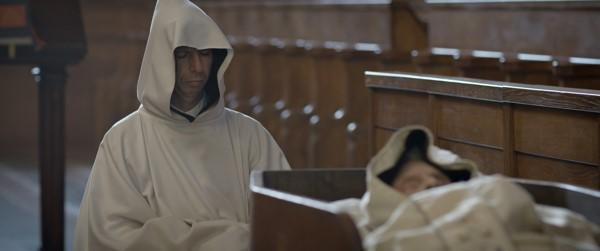‘Do you ever think that you’ve wasted your life?’ The questioner was a middle-aged man, the one being quizzed his uncle, a Trappist monk, who was celebrating his 90th birthday. The monk paused thoughtfully just for a moment. Then he answered, with a grin: ‘Possibly; but no more than you’ve wasted yours.’
Outside the City, a documentary by Nick Hamer, shows the everyday life of the only community of Cistercians of the Strict Observance, also known as Trappists, in England. Their abbey is at Mount St Bernard, outside the city of Leicester in the East Midlands. It was founded in 1835 and a few decades ago had almost 100 monks, who ran a thriving dairy farm and established a daughter house in Cameroon. Now there are just 25, half of whom are aged over 80, and one thread running through the film is how the community is adapting to try and ensure its future.
Here they took a lead from their brothers in Belgium and the Netherlands, who are best known as expert brewers. Each abbey produces its own distinctive Trappist beer, and these are much sought after. So over five years, under the careful eye of an energetic young abbot, Fr Erik Varden, the farm was closed and a state-of-the-art brewery was constructed. Named Tynt Meadow, after the field that the abbey was built on, to date more than 30,000 bottles of the beer have been produced, and the monks struggle to keep up with the demand for it.
While the younger members of the community, a highly cosmopolitan group, master the intricacies of a high-tech brewing process, the older men have other concerns. One of the main purposes of the monastic life, we’re told by one of them, is to prepare for a good death, and over the course of a year Nick Hamer clearly got close to some of the monks who were facing that prospect. They talked freely about the changes they have seen, what brought them to this way of life originally and what has kept them there, and what it means to be a monk in today’s world. The film doesn’t shy away from showing the funerals of two of those previously interviewed, in which the monks are interred without coffins, simply wrapped in their habits in graves laboriously dug in the stony earth of the monastic cemetery.
Perhaps the hardest task in any film of a religious community is to offer a sense of the prayer which is the mainspring of its life. Gatherings in the chapel for Mass, for the celebration of the Divine Office, and for the vow ceremony of a novice (as well as for the afore-mentioned funerals) punctuate the film as they do the life of the monastery. The liturgies are simple, in accord with the spirituality of the Cistercians, founded in reaction to the more elaborate lifestyle and prayer of the Benedictines. I was more struck, as was an applicant seeking to join the community, by the way in which some of the monks, having spent a day that includes seven periods of formal communal prayer, would then find a dark corner of the chapel late in the evening to continue their own quiet conversation with God.
It took Nick Hamer eighteen months to get the community’s permission to make the film. He was first sent an extensive reading list by the abbot, and then invited to join fully in the life of the community for some time. Only then did the community decide by vote to let him go ahead. When asked how the monks had reacted to the finished film, he said that they had laughed at seeing each other. A group committed to living together for life gets to know each other very well, and they reacted with humour to the foibles, as well as with affection to the strengths and occasional weaknesses, of each, being played out on the screen.
In the end these are lives that do not appear to have been wasted. They do come across as dedicated. Dedicated to that stripping away of inessentials which leads to the possibility of a good death. Dedicated to making the changes demanded if the community is to survive in a very secular society. And dedicated to praying for that society and its needs, even though they live hidden from it. It’s a dedication laced with humour, enabling a man who has spent more than seven decades as a monk to contemplate with equanimity the possibility that he might have lived in a way that others regard as a waste. But no more so than any life, and just as hard to evaluate accurately from the outside.
Correction: This review was updated on 10 June 2020 to reflect the fact that the Mount St Bernard community are the only Trappist community in England, not Britain. Apologies for the error.






